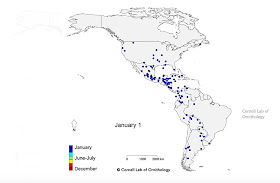 |
| Bird migration routes by eBird- New York Times |
The first migration study was by marking swans with a nick in their beak in 1560 England. Other methods listed in Wikipedia (scroll down to "study techniques") have included "an older technique to quantify migration involves observing the face of the moon towards full moon and counting the silhouettes of flocks of birds as they fly at night."
A story in the New York Times describes an exciting new approach involving citizen science. Ornithologists at Cornell Lab of Ornithology have compiled more than a million observations reported by amateur bird watchers through eBird. Many of our own Master Naturalists have participated through GOAS* field trips and as observant birders.
Nocturnal migration is difficult to study as the birds tend to take off 30-45 minutes after sunset. Cornell's Birdcast program is combining eBird data with two other high-tech data sources. Flight calls of migrating birds are species specific, allowing species identification during nocturnal flights.
Weather Surveillance Radar (WSR-88D) network has over 140 sites dedicated to collecting meteorological phenomena. These can also track the movement of masses of birds at night, "determining where flights are occurring, how many birds are aloft, and in what direction and speed they are moving." (Birdcast) While not species specific, this can be correlated to flight calls and eBird data to describe species-specific bird migration routes.
Even if you don't read the article, this link is worth a click just to see the flow of migrating species shown as moving dots over the year.
* GOAS - Greater Ozarks Audubon Society.
This story was contributed by my fantastic editor and wonderful wife.